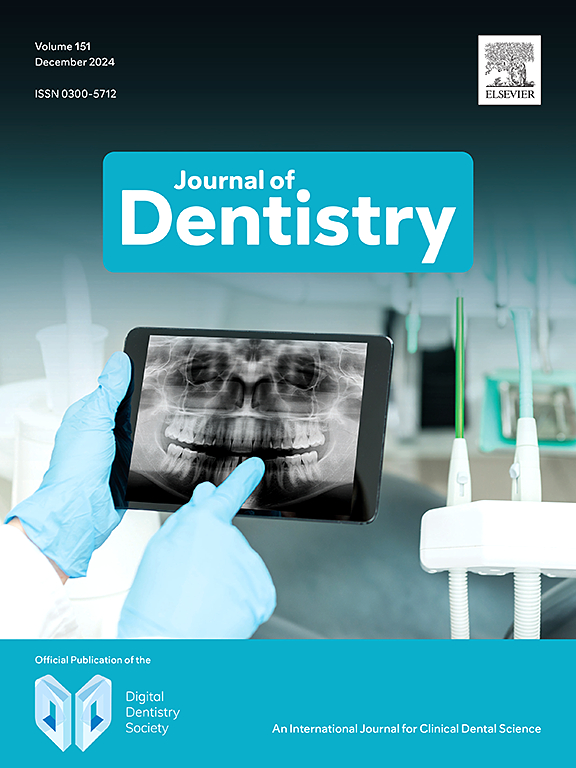数字与传统可摘全口义齿:无牙患者临床效果和成本效益的回顾性研究:数字义齿的临床效果和成本效益分析。
IF 4.8
2区 医学
Q1 DENTISTRY, ORAL SURGERY & MEDICINE
引用次数: 0
摘要
目的:本研究旨在比较传统和数字修复方案的临床效果和成本效益,特别关注磨铣和3d打印数字可移动全口义齿。方法:在锡耶纳大学活动义齿科进行回顾性临床研究,将60例患者分为两组:30例使用常规全口义齿,30例使用数字全口义齿(研磨15例,3d打印15例)。临床结果通过治疗前和治疗后6个月的OHIP-14、咬合力测量和咀嚼性能测试进行评估。记录并比较各组的治疗相关指标,包括主席时间、随访时间和实验室费用。统计分析传统全口义齿与数字全口义齿、磨铣数字全口义齿与3d打印数字全口义齿之间的差异。结果:与传统义齿相比,全口义齿可显著减少患者的椅侧时间,其平均时间为154.31±13.19 min,而传统义齿为218.00±20.75 min (p < 0.0001)。与传统义齿相比,数字义齿的实验室费用(€378.79±137.46 vs€459.15±63.72,p = 0.0059)具有统计学意义上较低。在咬合力和咀嚼性能方面,两组间无统计学差异。OHIP-14评分显示患者对义齿的满意度略低,但差异无临床意义。结论:数字活动义齿,包括研磨和3d打印模型,提供了传统义齿的实用和高效的替代方案,特别是在减少椅子上的时间和实验室成本方面。临床意义:数字活动义齿为传统义齿提供了一种实用而有效的替代方案,特别是在减少椅子边的时间和成本方面。这些简化的数字协议可以应用于住宅设施或国家医疗保健计划,为更多的患者提供假肢护理。本文章由计算机程序翻译,如有差异,请以英文原文为准。
Digital vs. conventional removable complete dentures: A retrospective study on clinical effectiveness and cost-efficiency in edentulous patients
Objectives
This study aimed to compare the clinical effectiveness and cost-efficiency of conventional and digital prosthodontic protocols, with a specific focus on milled and 3D-printed digital removable complete dentures.
Methods
This retrospective clinical study was conducted at the Removable Prosthodontics Department of the University of Siena. 60 patients were divided into two groups: 30 received conventional complete dentures, while the remaining 30 received digital complete dentures (15 milled and 15 3D-printed). Clinical outcomes were assessed using OHIP-14, bite force measurements, and masticatory performance tests before and six months after treatment. Treatment-related metrics, including chairside time, follow-up time, and laboratory costs, were recorded and compared across the groups. Statistical analysis was performed to determine the significance of differences between conventional and digital complete dentures, as well as between milled and 3D-printed digital complete dentures.
Results
The study revealed that digital complete dentures significantly reduced chairside time compared to conventional dentures, with average times of 154.31 ± 13.19 min for digital dentures and 218.00 ± 20.75 min for conventional dentures (p < 0.0001). Laboratory costs were found to be statistically lower for digital dentures, (€378.79 ± 137.46 vs. €459.15 ± 63.72, p = 0.0059) compared to conventional dentures. No statistically significant differences were observed in bite force or masticatory performance between the groups. OHIP-14 scores indicated slightly lower patient satisfaction with digital dentures, but the difference was not clinically significant.
Conclusion
Digital removable dentures, including both milled and 3D-printed models, offer a practical and efficient alternative to conventional dentures, particularly in terms of reducing chairside time and laboratory costs.
Clinical significance
Digital removable dentures offer a practical and efficient alternative to conventional dentures, particularly in terms of reducing chairside time and costs. These simplified digital protocols could be applied in residential facilities or within national healthcare programs, improving access to prosthetic care for a larger number of patients.
求助全文
通过发布文献求助,成功后即可免费获取论文全文。
去求助
来源期刊

Journal of dentistry
医学-牙科与口腔外科
CiteScore
7.30
自引率
11.40%
发文量
349
审稿时长
35 days
期刊介绍:
The Journal of Dentistry has an open access mirror journal The Journal of Dentistry: X, sharing the same aims and scope, editorial team, submission system and rigorous peer review.
The Journal of Dentistry is the leading international dental journal within the field of Restorative Dentistry. Placing an emphasis on publishing novel and high-quality research papers, the Journal aims to influence the practice of dentistry at clinician, research, industry and policy-maker level on an international basis.
Topics covered include the management of dental disease, periodontology, endodontology, operative dentistry, fixed and removable prosthodontics, dental biomaterials science, long-term clinical trials including epidemiology and oral health, technology transfer of new scientific instrumentation or procedures, as well as clinically relevant oral biology and translational research.
The Journal of Dentistry will publish original scientific research papers including short communications. It is also interested in publishing review articles and leaders in themed areas which will be linked to new scientific research. Conference proceedings are also welcome and expressions of interest should be communicated to the Editor.
 求助内容:
求助内容: 应助结果提醒方式:
应助结果提醒方式:


